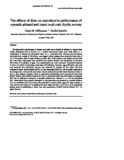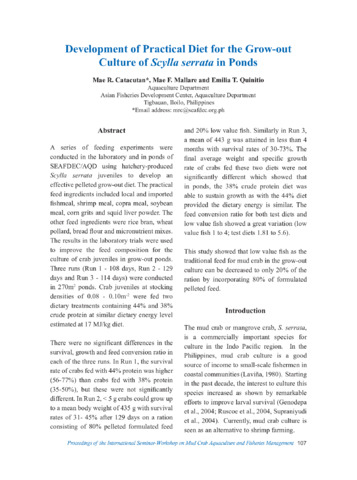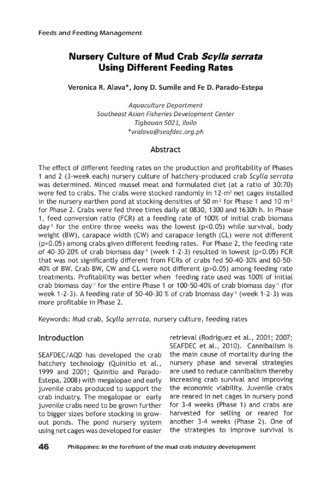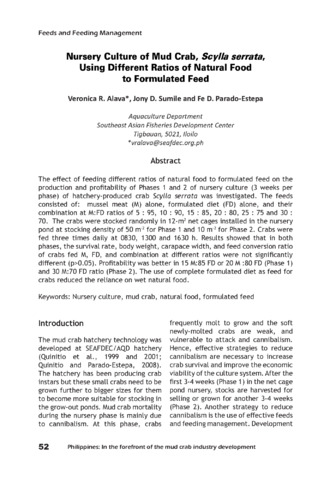The effects of diets on reproductive performance of eyestalk ablated and intact mud crab Scylla serrata
Share
Abstract
The reproductive performance of female mud crabs was evaluated as affected by various diets. Dietary treatments were as follows: D1 — natural diet (mussel meat, squid, trash fish); D2 — combination of natural and formulated diets; D3 — formulated diet. Pond-sourced broodstock, with initial body weight of 300–400 g, were tagged in their carapace then stocked in three units of 10 m3 broodstock tanks at eight females per tank. Half of the females were ablated and the other half were intact. Spawnings were monitored and berried females were transferred to individual 500-l tanks for incubation of eggs. Four experimental runs were conducted. Broodstock response in terms of number of spawnings, spawnings with hatching, fecundity, egg fertilization rate, total zoea produced and broodstock survival was enhanced in females fed the mixed diet (D2) compared to those fed the natural diet (D1) or the formulated diet (D3). Larval quality measured as larval stage index followed the same trend. Results further showed that intact females fed diets D1 and D2 gave higher numerical values in reproductive performance and zoea growth index than ablated females while ablated females fed diet D3 performed better than their intact counterparts. This may be attributed to presence of essential nutrients and vitamins A, C, E in the formulated diet. Latent period from gonadal maturation to first spawning was shortened by eyestalk ablation. Use of a combined diet would ensure the production of good quality eggs and large numbers of zoea with the best chance of completing the larval stages and thus, would serve as an appropriate starting point in establishing a viable mud crab aquaculture.
Suggested Citation
Millamena, O. M., & Quinitio, E. (2000). The effects of diets on reproductive performance of eyestalk ablated and intact mud crab Scylla serrata. Aquaculture , 181(1-2), 81-90. https://doi.org/10.1016/S0044-8486(99)00214-8
Subject
Taxonomic term
Collections
- AQD Journal Articles [1248]
Related items
Showing items related by title, author, creator and subject.
-
Development of practical diet for the grow-out culture of Scylla serrata in ponds
Catacutan, Mae R.; Mallare, Mae F.; Quinitio, Emilia T. (Rajiv Gandhi Centre for Aquaculture (MPEDA), 2015)A series of feeding experiments were conducted in the laboratory and in ponds of SEAFDEC/AQD using hatchery-produced Scylla serrata juveniles to develop an effective pelleted grow-out diet. The practical feed ingredients ... -
Nursery culture of mud crab Scylla serrata using different feeding rates
Alava, Veronica R.; Sumile, Jony D.; Parado-Estepa, Fe D. (Aquaculture Department, Southeast Asian Fisheries Development Center, 2017)The effect of different feeding rates on the production and profitability of Phases 1 and 2 (3-week each) nursery culture of hatchery-produced crab Scylla serrata was determined. Minced mussel meat and formulated diet (at ... -
Nursery culture of mud crab, Scylla serrata, using different ratios of natural food to formulated feed
Alava, Veronica R.; Sumile, Jony D.; Parado-Estepa, Fe D. (Aquaculture Department, Southeast Asian Fisheries Development Center, 2017)The effect of feeding different ratios of natural food to formulated feed on the production and profitability of Phases 1 and 2 of nursery culture (3 weeks per phase) of hatchery-produced crab Scylla serrata was investigated. ...




